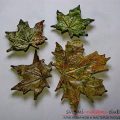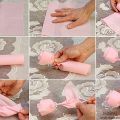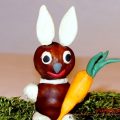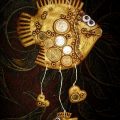
Crafts, how and what to do, photos and detailed instructions.
No generation of schoolchildren in lower gradesparticipated in traditional autumn exhibitions of crafts from various materials. Guys with their own hands create amusing toys made of acorns, dried flowers and twigs, seeds, spikelets, pebbles, shells. This article will help to prepare interesting crafts for the school. For crafts, any material that nature has given is good. The main thing is to let the fantasy unfold. And then any interesting knot, ugly potatoes or a handful of simple acorns can become unique fairy creatures or funny little men. Children themselves master these little miracles and with the same pleasure go in search of the necessary material. Going to the forest or park can become a real journey to nature. 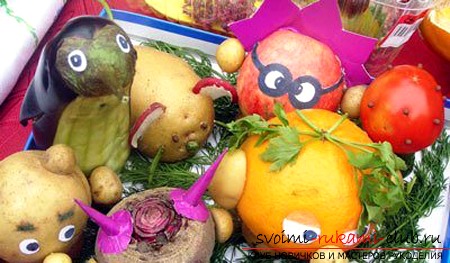 Forest in the autumn state of "the eyes of charm"mosaic of colorful foliage - and asks for masterpieces: for bouquets, autumn wreaths, glued pictures in frames or hand-made articles for school. Autumn Foliage Leaf collection does not take much time. If for crafts you need flat leaves, it fits between the pages of old books, or wrapped in newspapers and fit into the press. A day later - two, giving moisture to the paper, the material is ready for work. You can iron the leaves through waxed paper, if it is required urgently (Iron hold no more than ten seconds).
Forest in the autumn state of "the eyes of charm"mosaic of colorful foliage - and asks for masterpieces: for bouquets, autumn wreaths, glued pictures in frames or hand-made articles for school. Autumn Foliage Leaf collection does not take much time. If for crafts you need flat leaves, it fits between the pages of old books, or wrapped in newspapers and fit into the press. A day later - two, giving moisture to the paper, the material is ready for work. You can iron the leaves through waxed paper, if it is required urgently (Iron hold no more than ten seconds). 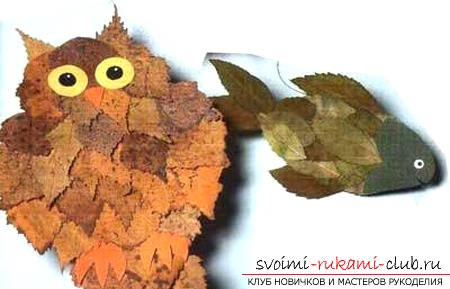
 Creativity with dry leaves is available to children withsmall age. The leaves look great in bulk ikebana and flat bouquets. From them you can make beautiful applications for every taste. Crafts are made of plywood or cardboard. On a flat surface, foliage is simply laid out. A sheet is cut out of the desired shape, or its natural beauty is preserved and it is used entirely. Foliage is perfectly combined with the petals of flowers, berries, acorns. Acorns Oak provides materials for decorative processing: wood, leaves, bark and acorns - in skillful hands will become beautiful products. This cartoon characters and pretty jewelry.
Creativity with dry leaves is available to children withsmall age. The leaves look great in bulk ikebana and flat bouquets. From them you can make beautiful applications for every taste. Crafts are made of plywood or cardboard. On a flat surface, foliage is simply laid out. A sheet is cut out of the desired shape, or its natural beauty is preserved and it is used entirely. Foliage is perfectly combined with the petals of flowers, berries, acorns. Acorns Oak provides materials for decorative processing: wood, leaves, bark and acorns - in skillful hands will become beautiful products. This cartoon characters and pretty jewelry.  In the crafts, the acorn and its base are used. To keep the work from the acorns, it is kept in the cold. Raw acorns are easier to handle.
In the crafts, the acorn and its base are used. To keep the work from the acorns, it is kept in the cold. Raw acorns are easier to handle. 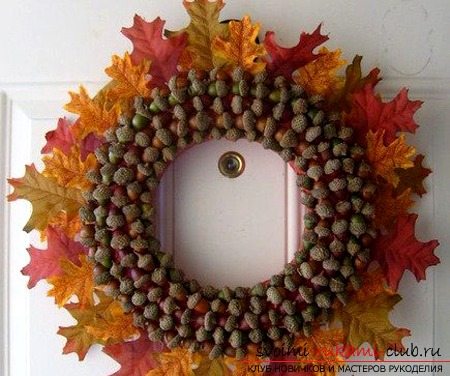 Working with acorns requires some skills,so it's better to start with a simple one. Bunny from acorn As a body takes a large acorn. Points of attachment of the tail, cervix and paws are marked, matches will be inserted there. Shilom holes are pierced. For the head - a round small acorn. A felt-tip pen and a nose are drawn. Carefully pierce holes for the neck and ears. Assembly: in the holes are inserted matches-ears, paws, tail, and the neck is fixed head.
Working with acorns requires some skills,so it's better to start with a simple one. Bunny from acorn As a body takes a large acorn. Points of attachment of the tail, cervix and paws are marked, matches will be inserted there. Shilom holes are pierced. For the head - a round small acorn. A felt-tip pen and a nose are drawn. Carefully pierce holes for the neck and ears. Assembly: in the holes are inserted matches-ears, paws, tail, and the neck is fixed head. 
 Chestnut
Chestnut  It is better to take just fallen from the tree chestnuts. Soft, they are easily pierced. Chestnuts are stored at medium temperature and humidity. Because of the severity of chestnuts are held together only on a horizontal plane. They are connected with glue or with an awl and matches.
It is better to take just fallen from the tree chestnuts. Soft, they are easily pierced. Chestnuts are stored at medium temperature and humidity. Because of the severity of chestnuts are held together only on a horizontal plane. They are connected with glue or with an awl and matches.  Horse from the chestnut This will require chestnuts,matches, woolen threads. For the body and head are taken chestnuts larger. Threads are cut, of which a ponytail and a mane are made. Shilom in the chestnut pierces the holes for the legs, head and tail. In the holes are threaded the tail, legs and neck. A head is attached to the match-neck, with a mane attached with glue.
Horse from the chestnut This will require chestnuts,matches, woolen threads. For the body and head are taken chestnuts larger. Threads are cut, of which a ponytail and a mane are made. Shilom in the chestnut pierces the holes for the legs, head and tail. In the holes are threaded the tail, legs and neck. A head is attached to the match-neck, with a mane attached with glue.  For the school, exhibition works make it more difficult, withadditional materials: cardboard, plasticine, cloth. Also plastic, thread, wire, glue. And then there are worthy exposition exhibits, storing the warmth, strength and beauty of nature.
For the school, exhibition works make it more difficult, withadditional materials: cardboard, plasticine, cloth. Also plastic, thread, wire, glue. And then there are worthy exposition exhibits, storing the warmth, strength and beauty of nature.
